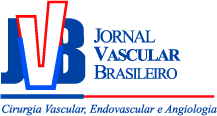Neurofibromatosis type 1, fibromuscular dysplasia, and ischemic stroke: an association lost in time? A case report
Neurofibromatose tipo 1, displasia fibromuscular e acidente vascular cerebral isquêmico: uma associação perdida no tempo? Um relato de caso
Igor Oliveira da Fonseca; Gustavo José Luvizutto; Isaac Pantaleão Souza; André Petean Trindade; Carlos Clayton Macedo de Freitas; Rodrigo Bazan; Gabriel Pinheiro Modolo
Abstract
Keywords
Resumo
Resumo: A neurofibromatose tipo 1 (NF1) é uma causa rara de acidente vascular cerebral isquêmico (AVCi) na população geral. Neste estudo, relatamos o caso de um paciente jovem com AVCi, com diagnóstico de NF1 associada a displasia fibromuscular. O estudo angiográfico demonstrou oclusão da carótida interna direita, logo após sua origem, e esquerda, antes da porção intracraniana. A ressonância magnética do encéfalo mostrou delimitação de um infarto na região frontoparietal direita. Apesar desses achados concomitantes na neuroimagem, essa associação é rara, sendo difícil de estabelecer a contribuição de cada uma dessas doenças no desfecho, tampouco qual o melhor tratamento a ser implementado e qual o prognóstico.
Palavras-chave
Referências
1 Kim ST, Brinjikji W, Lanzino G, Kallmes D. Neurovascular manifestations of connective-tissue diseases: a review. Interv Neuroradiol. 2016;22(6):624-37.
2 McClatchey AI. Neurofibromatosis. Annu Rev Pathol. 2007;2(1):191-216.
3 Cairns AG, North KN. Cerebrovascular dysplasia in neurofibromatosis type 1. J Neurol Neurosurg Psychiatry. 2008;79(10):1165-70.
4 Takeshima Y, Kaku Y, Nishi T, Mukasa A, Yamashiro S. Multiple cerebral aneurysms associated with neurofibromatosis type 1. J Stroke Cerebrovasc Dis. 2019;28(7):e83-91.
5 Terry AR, Jordan J, Schwamm L, Plotkin S. Increased risk of cerebrovascular disease among patients with neurofibromatosis type 1. Stroke. 2016;47(1):60-5.
6 Hamilton SJ, Friedman JM. Insights into the pathogenesis of neurofibromatosis 1 vasculopathy. Clin Genet. 2000;58(5):341-4.
7 Boot E, Ekker MS, Putaala J, Kittner S, De Leeuw FE, Tuladhar AM. Ischaemic stroke in young adults: a global perspective. J Neurol Neurosurg Psychiatry. 2020;91(4):411-7.
8 Gorelick MH, Powell CM, Rosenbaum KN, Saal HM, Conry J, Fitz CR. Progressive occlusive cerebrovascular disease in a patient with neurofibromatosis type 1. Clin Pediatr. 1992;31(5):313-5.
9 Barreto-Duarte B, Andrade-Gomes FH, Arriaga MB, Araújo-Pereira M, Cubillos-Angulo JM, Andrade BB. Association between neurofibromatosis type 1 and cerebrovascular diseases in children: a systematic review. PLoS One. 2021;16(1):e0241096.
10 Lummus S, Breeze R, Lucia M, Kleinschmidt-DeMasters B. Histopathologic features of intracranial vascular involvement in fibromuscular dysplasia, ehlers- danlos Type IV, and neurofibromatosis I. J Neuropathol Exp Neurol. 2014;73(10):916-32.
11 Oderich G, Sullivan T, Bower T, et al. Vascular abnormalities in patients with neurofibromatosis syndrome type I: Clinical spectrum, management, and results. J Vasc Surg. 2007;46(3):475-84.
12 Gornik HL, Persu A, Adlam D, et al. First International Consensus on the diagnosis and management of fibromuscular dysplasia. Vasc Med. 2019;24(2):164-89.
13 Miyakis S, Lockshin MD, Atsumi T, et al. International consensus statement on an update of the classification criteria for definite antiphospholipid syndrome (APS). J Thromb Haemost. 2006;4(2):295-306.
Submetido em:
29/08/2022
Aceito em:
27/03/2023

